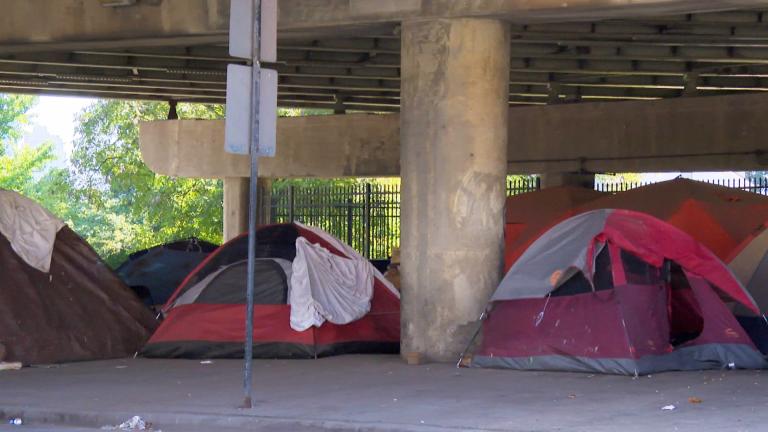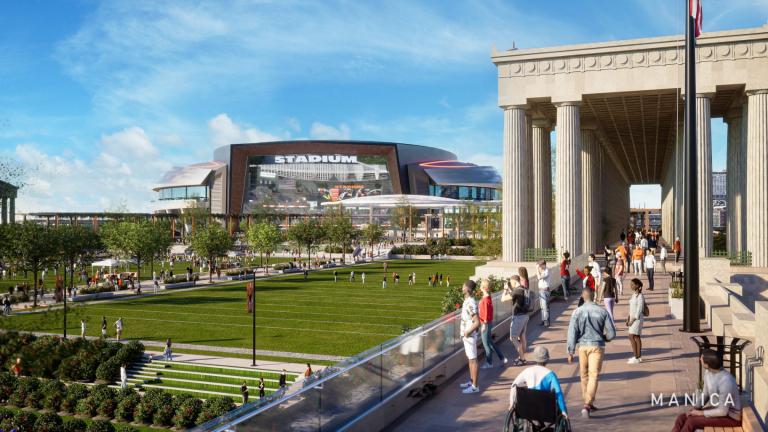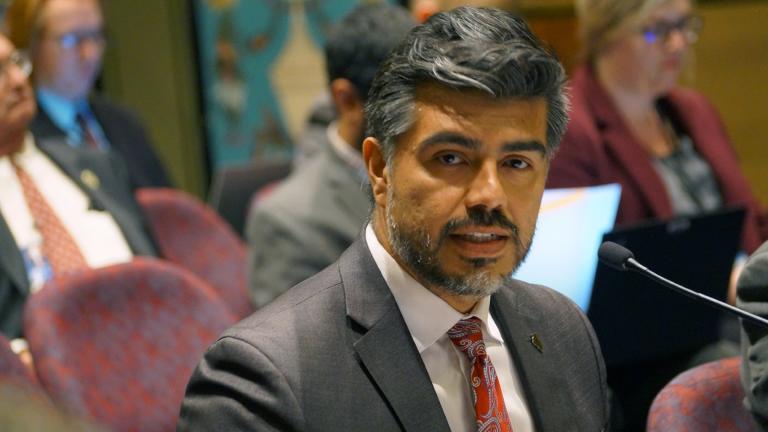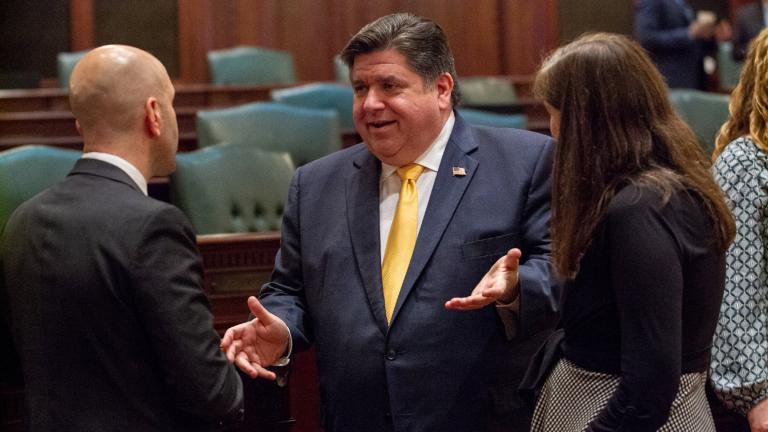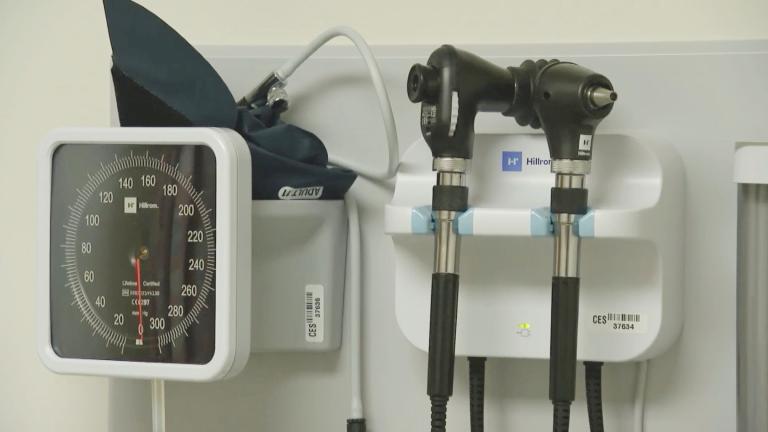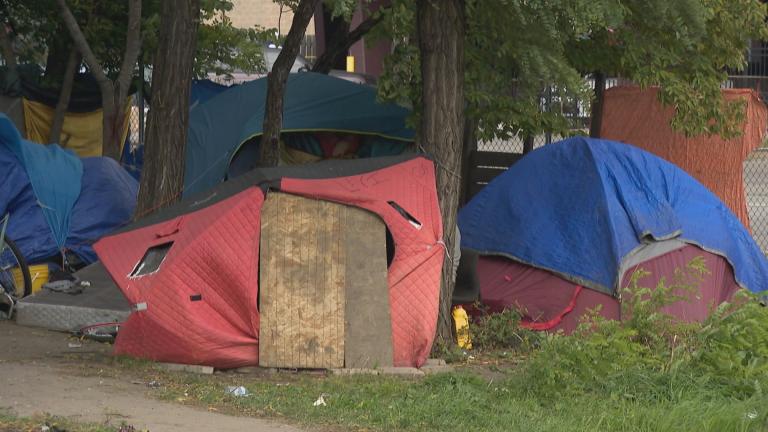Video: The WTTW News Spotlight Politics team discusses Gov. J.B. Pritzker’s upcoming budget address and more of the day’s biggest stories. (Produced by Emily Soto)
If Illinois continues spending next fiscal year as it has been this year, the state will face an $891 million deficit.
Gov. J.B. Pritzker, who prides himself on restoring Illinois’ financial status after the devastation of the 2015 to 2017 partisan budget fights, has repeatedly committed to keeping revenues and spending in check.
“Substantially reducing the structural deficit reflects the commitment of the Governor and the General Assembly to achieving fiscal health for Illinois for the foreseeable future. The Governor remains committed to taking steps to further improve Illinois’ fiscal position,” reads a recent budget report published by the Pritzker administration.
Pritzker is set to spell out exactly how he plans to do that on Wednesday, when he delivers an annual combined state of the state and budget address.
The $891 million fiscal year 2025 deficit figure, which was projected in that November report by Pritzker’s own Governor’s Office of Management and Budget (GOMB), assumes a $350 million increase in the state’s main K-12 education funding formula, an annualized bump in cost for Medicaid enhancements and “moderate growth rates in the various categories of state spending.”
But it does not include what the report describes as “significant changes to base programs” which could bring savings, or could come with a cost.
It leaves the governor in a trick-box he’s been able to evade in recent years, as federal COVID-19 relief grants, inflation and other economic factors gave him and the other Democrats who control the General Assembly a degree of financial cushion in crafting spending plans.
Those factors led GOMB to revise up its revenue projections to $52 billion for the fiscal year, which runs through June.
Even after accounting for an extra $1 billion in revenues, pressures “that will offset the revenue gains including increased case load pressures at Department on Aging and DHS (Department of Human Services)” and “potential spending pressures related to asylum seekers at DHS,” GOMB said the state is set to end this 2024 fiscal year with a $422 million surplus – the opposite of the in-the-red situation lawmakers are staring down as they begin the budgeting process anew.
Going into Wednesday, pressures on Pritzker to spend more – to help lift poorly-funded schools, to ease the burden on families raising children, to lower inheritance tax bills, to get more money to local governments, to assist sports stadium and to create tax credits designed to make Illinois more competitive – are mounting.
Credit ratings agencies and Republicans alike are sure to keep a sharp eye on the numbers.
State Rep. Tony McCombie, the House GOP leader, said she’s working to ensure the minority party is part of negotiations, unlike previous years. Her priority, she said recently, is no more pork projects or new programs, and to ensure there’s no tax increase.
“You often hear our (Democratic) colleagues say that the budget is a moral document,” she said. “We couldn’t agree more. The problem is that it is used as a political football and that has also got to stop.”
Migrant Response
More than 800 buses have traveled to Chicago from Texas since the end of August 2022, making unscheduled drop-offs of migrants who are mostly seeking asylum from Venezuela. Since Saturday, 35,692 migrants have come to the city, according to city data.
Pritzker will ask for the state to spend at least $342 million on their care – just under half of which will likely come from this year’s budget, and just more than half from next year’s.
Illinois initially spent $478 million on a response to the migrant influx.
In November, Pritzker announced another $160 million that would be spent on additional shelter space, casework assistance and an intake center. The governor used money already appropriated, but has said he will ask legislators to approve that money.
Last week, Pritzker and Cook County Board President Toni Preckwinkle made a joint announcement – notably without Chicago Mayor Brandon Johnson – pledging to spend more to “ensure shelter, wraparound services and healthcare remain available for asylum seekers sent to Chicago from the Texas border.”
Preckwinkle would add $70 million to Cook County’s $100 million on migrant spending.
On the state side, Pritzker would add to the $478 million and $160 million spends with another $182 million, “which will be part of the Governor’s upcoming Fiscal Year 2025 budget proposal to the General Assembly,” according to the Feb. 15 news release.
Though Pritzker publicly committed to that amount, the legislature still needs to agree. With Democrats in charge of the General Assembly, Pritzker should get his way, but it could take negotiations and other spending promises to make it happen.
Illinois could need to spend more in 2025 on the migrant response, as well.
“Following a long-term planning exercise, State, County and City teams concluded that an additional estimated $321 million is needed to maintain shelter and services this calendar year, on top of previously committed funding,” the release said.
It’s unclear how the remaining $69 million will be made up, given that Johnson has been equivocal. When asked last week, the mayor repeatedly insisted he’s committed to the migrant response but that “matters have to be worked through.”
Regardless, Pritzker and Preckwinkle said $321 million is needed for an effective migrant response through this calendar year.
If so, given Illinois’ July through June fiscal year, the state portion of $182 million would carry through only half of the 2025 fiscal year – meaning that may not be the final amount out of next year’s budget.
Though it’s possible the busloads may end or slow come 2025, expenses are likely to continue, leaving open the possibility that Pritzker will either ask for more upfront in his budget address or that he’ll once again have to come back to lawmakers in 2025 to approve a supplemental budget.
Health Benefits for Immigrants
A main point of contention in this year’s budget was spending on the Health Benefits for Immigrant Adults and Health Benefits for Immigrant Seniors programs, which gives Medicaid-like health care to undocumented Illinois residents aged 42 and up (children are covered under a different program).
Advocates fought to include all adults, starting at age 19, but failed mostly due to cost concerns. That’s still a goal, albeit one that could hit another fiscal wall.
“What are the moral priorities? And that’s Illinois citizens. We saw last year $1.2 billion in healthcare costs, Cadillac health care costs, for non-citizens and that certainly is not a priority of the taxpayers that I’m hearing from,” said McCombie, the House minority leader. “We have to talk about what is important, a priority, for Illinois citizens. That’s No. 1.”
Backers, however, argue that expansion – and getting individuals preventative care that heeds off costly, emergency medical needs – would bring long-term savings.
Education
Illinois spends about 20% of its general funds on education.
Pritzker would be hard-pressed to even suggest keeping spending on schools flat.
Under a 2017 “evidence-based funding” law, poorer districts can depend on the state for help reaching an “adequacy” level.
Estimates peg the amount needed at an out-of-reach $2.5 billion, but the law calls for Illinois to add $350 million more a year to that target.
GOMB’s projections assume that Pritzker and lawmakers will do just that, though education advocates are lobbying for a couple hundred million more.
The Illinois State Board of Education is recommending the state spend just more than $11 billion on schools next year.
Pritzker last year unveiled a signature “Smart Start” program to expand preschool access and early childhood programs. This year, he’s expected to add onto the $250 million first-year investment.
Illinois’ universities and community colleges are also seeking funding bumps. The Illinois Board of Higher Education is seeking a 6.8% increase, or $179 million, which would cover more tuition grants for low-income students and other priorities.
Pensions
Another fifth of Illinois’ budget goes toward retirement payments for state employees, teachers and university workers.
For long stretches, Illinois underfunded those pensions, leaving the state on the hook for paying down an unfunded liability totaling a gargantuan $141 billion as of June 2023.
A law that puts Illinois on a ramp toward reaching 90% funding by 2045 calls for Illinois to put $10.1 billion into pension in FY25, up from $9.8 billion this fiscal year.
Pritzker is sure to propose paying that full amount – he’d face the wrath of credit ratings agencies, not to mention fiscal hawks from his own party and a hit to the fiscally-prudent reputation he’s cultivated – should he not.
“I hope to see a balanced budget proposal, the way he’s (Pritzker’s) delivered on that since he took office,” Comptroller Susana Mendoza said. “And so my hope would be that the legislature continue to pass balanced budgets, that we look to save, and every opportunity that we can towards our rainy day fund and paying down additional pension obligations and that we hold the line on any non-essential new spending, right. That’s a good formula for success, to err on the side of being conservative with our budget estimates.”
Any “extra” money should be put toward pension stabilization, Mendoza said.
Municipal Money
From the time Illinois began taxing income in 1969, municipalities got a cut under what’s known as the Local Government Distributive Fund.
That cut used to be 10%, but it was reduced in 2011 to 6%. It hasn’t been fully restored since. The fund currently gets 6.47% of the share of individual state income tax collections.
The Illinois Municipal League is seeking to have the full 10% restored, and said doing so would be a means of keeping down property taxes.
“With the state’s improved financial condition, now is the time to invest in Illinois communities by returning a great portion of income taxes back to where they belong – right in the hands of Illinois communities,” said IML president Mark Kupsky, mayor of Fairview Heights, outside St. Louis. “Without an increase in (Local Government Distributive Fund), communities across Illinois will need to explore increases to other fees, taxes and property taxes.”
Sports Stadiums
The Chicago Bears are eager to call someplace other than Soldier Field home, be it at a domed stadium in suburban Arlington Heights or at a different lakefront location in the city.
On the baseball diamond, White Sox are potentially looking to move from Bridgeport’s Guaranteed Rate Field to a more central (but still South Side) location at The 78, where they could build a new stadium with fan views facing the skyline.
Crain’s Chicago Business reported last week that White Sox owner Jerry Reinsdorf will ask for $1 billion in public money to make it happen.
Initial attempts by the Bears to get state assistance via authorization to put a surcharge on tickets or a long-term freeze on property tax assessments at the stadium site failed to gain traction and didn’t come up for votes.
But the Bears are expected to take to the field again in another attempt to get a public lift – if not for the stadium itself, for infrastructure around it.
However, using public money to support wealthy owners of pro sports teams as they build their teams’ fresh colosseums is about as popular as trading up for Mitch Trubisky.
Tax Credits
Advocates from across the social and political spectrums want tax credits – to incentivize, to assist, to entice, to reward or to prevent.
Illinois offers a variety of tax credits now. There’s the Economic Development for a Growing Economy to support corporations growing jobs in Illinois, the Reimagining Energy and Vehicles program for those in the electric vehicle space and the Earned Income Tax Credit, which helps low-income workers and was expanded last year.
Among the credits lawmakers are advocating for this session:
- Keeping income tax at pace with inflation: As reported by WBEZ, with inflation high, Democrats “quietly” froze Illinois’ standard income tax exemption in the FY24 budget – saving the state money by ensuring the standard deduction was kept $200 lower than it otherwise would have jumped. House Bill 4998 explicitly restores the cost-of-living adjustment.
- Child tax credit: Illinois families with children who earn less than the state’s median income (roughly $75,000 for a pair of parents or $50,000 for single parents) would be a $300 per child tax credit, under House Bill 4917 / Senate Bill 3329. It’s a renewed effort, and perhaps in recognition of Illinois’ new fiscal constraints is sliced from a proposed $700 per child. This version would cost the state an estimated $300 million, but advocates’ pitch is that it would generate $1 billion in economic activity.
- Farm estate tax: The value of farmland is higher, but the income generated by the land isn’t keeping pace. A bipartisan group of legislators from central and downstate Illinois are proposing the Family Farm Preservation Act, which would increase the estate tax exemption for family farm estates by $2 million, up to $6 million.
- Reproductive care credit: Patients, their parents and health care providers would receive a tax credit if they move to Illinois to receive reproductive healthcare like abortions or gender affirming care (House Bill 5152).
- Business assists: The Illinois Manufacturer’s Association is advocating for “modernizing and making permanent” the Research and Development Tax Credit (House Bill 4457/ Senate Bill 163) and creating a tax credit for employers (House Bill 4435 / Senate Bill 1313) that help employees pay their student loans.
Some of the credits are supported by Republicans, even as they warn Illinois needs to watch its dollars.
Not all of the expansions in this year’s budget were “bad or were not needed” said state Rep. Norine Hammond, the deputy leader of House Republicans.
“But the challenge is how do we continue to balance those expansions on top of additionally rising costs and lowering revenues?” Hammond said.
Hammond said it’s “unfair” to “make promises to people and give them hope on issue and then not put the money there because we just don’t have it.”
Pritzker is set to make his address Wednesday in Springfield.
Contact Amanda Vinicky: @AmandaVinicky | [email protected]

